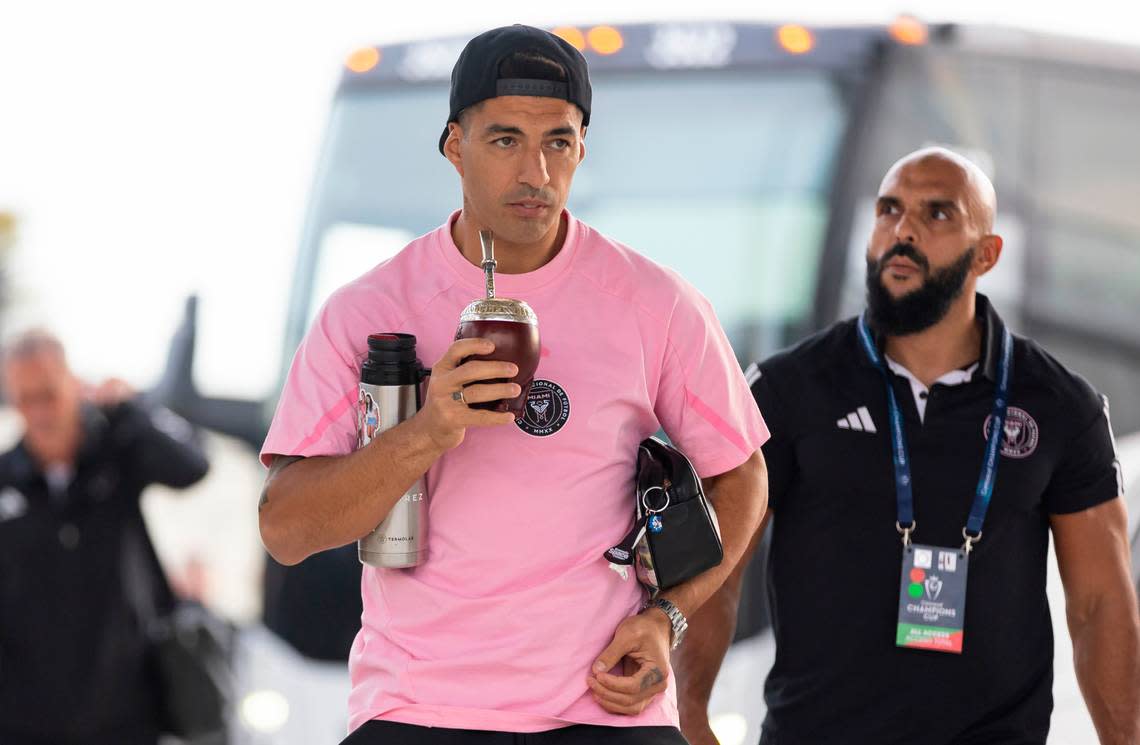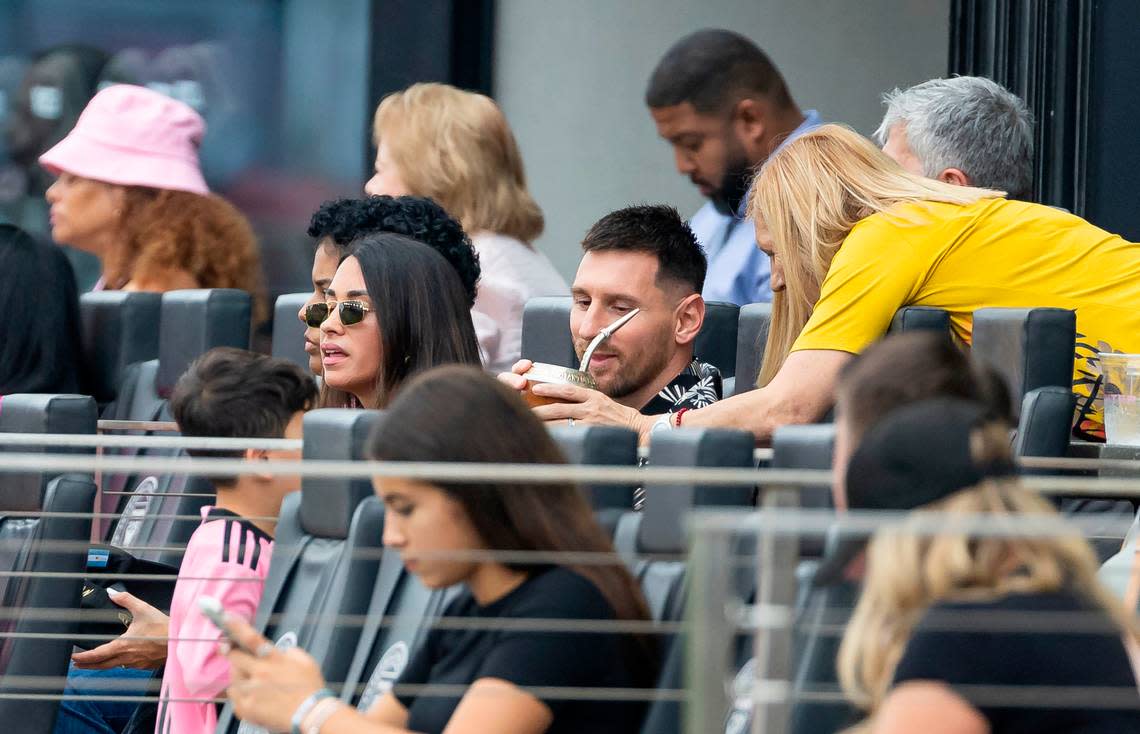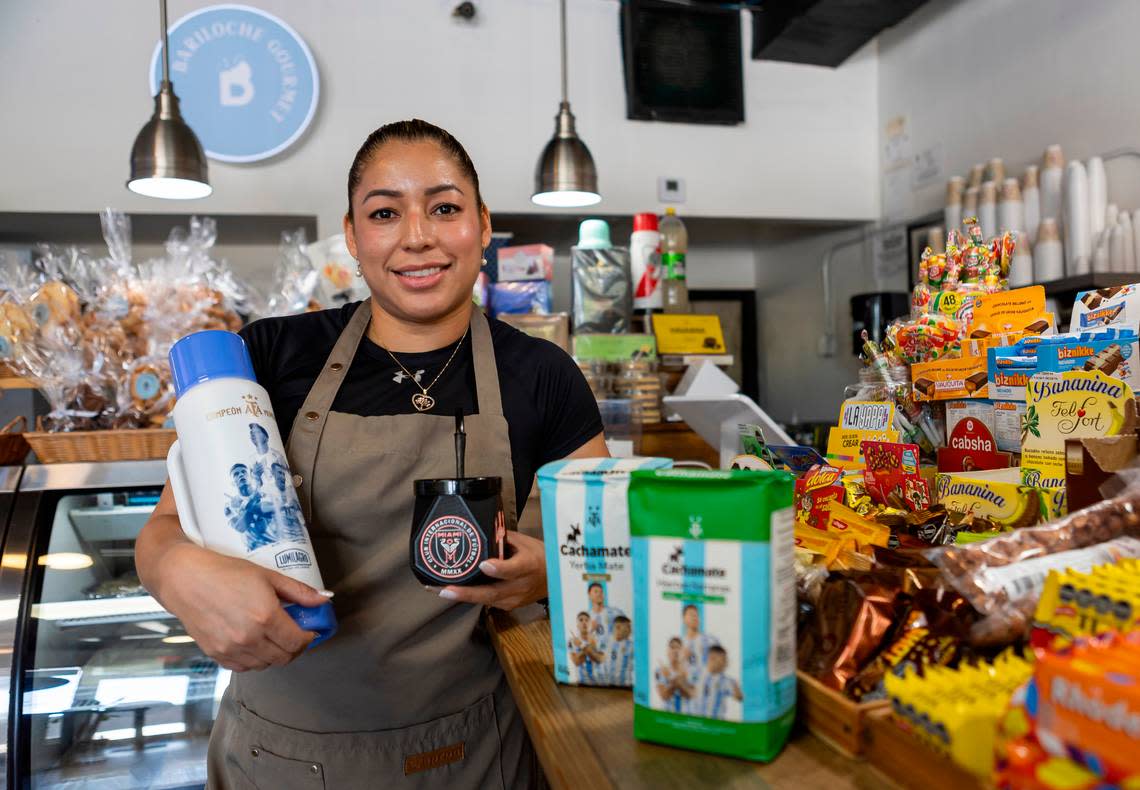Here’s the backstory behind yerba mate, the drink that fuels Messi and Inter Miami
The Inter Miami team bus pulls up to Chase Stadium on game day as fervent fans snap photos from behind a parking lot gate. One by one the pink-clad players file out and begin making the short trek to the locker room. Many of them are toting something you do not see in the hands of athletes from the NFL, NBA, NHL, or Major League Baseball.
It is a brown cup made of a hollowed calabash gourd. Sometimes the cup is made of metal, ceramic or wood, but the gourd is most popular. Most players have their cup (and an accompanying thermos) personalized with their initials, jersey numbers, names of their spouses and/or children, and logos of their favorite soccer clubs. Sticking out of the cup is a metal straw called a bombilla with a flat bulb-like strainer at the end.
Inside the cup is yerba mate, or just mate (pronounced mah-teh) for short, a bitter, caffeine-rich herbal drink made of the dried leaves and stems of the yerba plant. The term yerba mate is derived from the Spanish word hierba, which means grass or herb, and the indigenous Quechuan word mati, which means drinking container.
It has been consumed for centuries in South America, is the national beverage of Argentina and Uruguay, and is also popular in Brazil and Paraguay, which explains why so many of the world’s best soccer players, including Lionel Messi and Luis Suarez, don’t leave home without it.
The Argentine national team travels with large quantities of it. So does the Uruguayan national team. And Inter Miami does, too.
According to team nutritionist Daniela Lara, Inter Miami staff packed 25 pounds of yerba mate when the team traveled to Saudi Arabia, Hong Kong and Japan during the preseason. For a typical regular season road game, they bring along several bags of yerba mate, spare kettles, and straws.
“Many players bring their own, but we always travel with a few different brands of yerba, some are more bitter, some are less bitter, as the players have different tastes,” Lara said. “I would say at least half the team drinks mate, partly because the caffeine is a stimulant like coffee, so it wakes them up and makes them more alert and less fatigued, but also for its nutritional values and because it helps teammates bond before and after practice and games.”
Messi is one of six Argentine players on the Inter Miami roster. Coach Tata Martino and nearly his entire staff is from Argentina. Two players are Argentine American. Suarez is from Uruguay and Diego Gomez is from Paraguay, so they, too, are immersed in the mate culture.
“I started drinking it when I was young, and even more when I became a professional soccer player because in our culture, we prepare and share mate with our teammates as a way to go through good and bad times together,” said Argentine left back Franco Negri. “It’s been a fundamental part of every locker room I’ve played in. It brings us closer together.”

Midfielder Benjamin Cremaschi grew up in Key Biscayne but is from Argentine background and has been drinking mate for as long as he can remember. He travels with it when on road trips with Inter Miami and the U.S. national team.
“I like drinking it in the afternoon,” he said. “There are health benefits, but it’s a social thing, too. When you are with teammates in the training facility, you drink it, pass it around, and talk. It’s a nice part of our soccer culture.”
It is customary for one player to prepare the mate and then pass it around to share it with teammates. Negri has his jersey number on his cup, as well as his initials and those of his girlfriend.
“Some teammates from other countries are starting to try it,” Negri said. “Leo Campana, who is from Ecuador, didn’t used to drink it and now he likes it. The Americans have a harder time with it because they didn’t grow up with it, but they are trying because they want to adapt to the group.”
Inter Miami goalkeeper coach Sebastian Saja, a native of Argentina, said mate is as essential to an Argentine player as his cleats.
“For those of us from Argentina and Uruguay, mate is an indispensable part of our culture,” Saja said. “We can’t imagine a locker room without mate, or without a circle of people passing around a mate. From a very young age it’s something that is introduced to us by our parents, and in soccer it is a way to gather and share with your team. We need mate in the locker room at all times, before and after the training sessions and before games, too.”
Saja said he drank café con leche (coffee with milk) before school as a kid and in the afternoons would ask his father for a sip of his mate. He has three sons now, and the youngest, who is six years old, has started drinking mate.
“We grew up with it and we are seeing that it is starting to transcend Argentina, Uruguay and Paraguay, and players of other nationalities are drinking it,” Saja said. “I just have to be careful not to drink the very strong version after dinner because then it is hard for me to fall asleep. I did that once when I was a player, and I couldn’t fall asleep until 4 in the morning.”

A cup of yerba mate contains approximately 80 milligrams of caffeine, about the same as in a cup of brewed coffee. It also is an excellent source of polyphenol antioxidants, which helps shorten recovery rate after high intensity exercise.
“It is very low calorie, 12 to 15 calories in a cup, improves digestion, can reduce LDL, the bad cholesterol, and has vitamin A, C, E and zinc,” Lara said. “Some people put sweetener in it, but most athletes drink it without sweetener because it is healthier that way.”
To make mate, you fill the cup one-half to three-quarters with the yerba leaves. Cover the mouth of the mate with your hand. Turn it over and shake it to even out the leaf mixture, and keep the cup at a 45 degree angle.
Then, pour hot (but not boiling) water from your thermos over the leaves. Between 75 degrees to 85 degrees is ideal. Finally, you drink it with a filtered straw so you consume only the liquid, not the leaves or stems, and pass it around.

“It has so many benefits,” Saja said. “It is low calorie and helps curtail your hunger and it’s a stimulant, like coffee, so it keeps you alert.”
But the main reason players and coaches drink it, Saja said, is because it strengthens the team bond.
“When we’re on the bus, when we’re on the road, everywhere we go, we take our mate with us,” he said. “When you pass by a player or coach who has made mate, you ask if you can have some. People unfamiliar with our culture are taken aback by the idea of sharing a bombilla or sharing a cup of mate, but for us that is natural.
“It’s very rare to see a group of teammates drinking five or six different mates. Normally, one person prepares it and passes it around to the others. It is about sharing moments. When a new player comes to the team, you offer him a mate as an ice breaker, and that helps him integrate quicker to the group, at least players from South America who are familiar with the custom.”
Saja said he recently saw Inter Miami midfielder Julian Gressel, a German American who joined the team this year, drinking a mate.
Decorating the cups has also become more and more elaborate. Saja’s cup has the names of his three sons and his initials. One of his sons has one with his name and the logos of the Argentine national team, Inter Miami and Racing, his favorite Argentine soccer club.
Asked if he has a favorite brand of mate, Saja sheepishly admitted he prefers a Uruguayan brand called Canarias. “I will get in trouble with my Argentine compatriots for saying that, but the truth is a lot of players prefer that brand, too,” he said. “There is a yellow package and a green. The yellow is stronger, the green is mild. I like the yellow. It’s like a strong black coffee. Some people drink coffee. Some drink energy drinks. We drink mate.”
